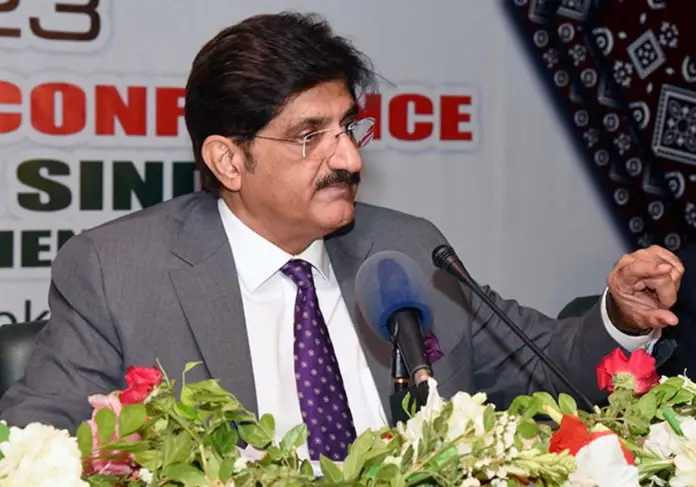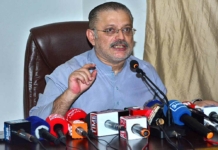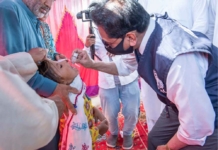Sindh Chief Minister Syed Murad Ali Shah, addressing a post-budget press conference on Wednesday, said the next year’s Rs1.73 trillion budget had 69.9 percent or Rs1.199 trillion current revenue expenditures (CRE), 3.18 percent or Rs54.5 billion current capital expenditures and 26.8 percent or Rs459.65 billion development expenditures.
“The CRE of Rs1.199 trillion could not be termed as non-development expenditures… it has 2.9 percent or Rs35.360 billion repair and maintenance (R&M) budget, which itself is part of development budget,” he said. The CM said the CRE also had 21.4 percent or Rs256.605 billion grants for educational, and health institutions and for procurement of buses for BRT routes, besides subsidies for social protection and right-off loans, 14.5 percent or Rs174.229 billion employees’ retirement benefits, 12.3 percent or Rs147.449 billion operating expenses and 42.5 percent or 509.732 billion employees-related expenses.
Murad said that the non-development expenditures would not be more than 60 percent of the total budget but even then his government was trying to control them. “Yes, the burden of Rs174.229 billion of employees’ retirement benefits is huge on the provincial exchequer and needs to be controlled,” he said and added his government was working on a scheme to introduce a new pension plan.
To a question, the CM said that his government was preparing a policy to offer registration of electric vehicles free of cost. “The POL prices are increasing day by day, therefore our government is planning to offer free registration of electric vehicles as an incentive,” he said, and added that he would announce the policy once it was approved by the cabinet. Replying to a question, the chief minister said that 40 percent POL quota of the government officers had been curtailed keeping in view the 40 percent increase in POL prices. “The POL allowance of the officers is the same in terms of money, but the commodity price has increased by 40 percent, which means they (officers) would be able to purchase 40 percent less fuel from their allowance,” he elaborated.
Therefore, according to the CM, the non-development expenditures would not be more than 60 percent of the total budget.
To a question, he said that the total development outlay for Karachi in 2022-23 was Rs125 billion.
Giving a break-up of the amount and the schemes, Murad said that Rs80.077 billion had been allocated for 750 Karachi-specific schemes of which Rs60.686 billion was for 483 ongoing schemes and Rs19.390 billion for 267 news schemes.
The CM said that Rs5 billion had been allocated from district ADP and Rs40.715 billion for seven projects through foreign project assistance. He also counted around 32 mega projects, including Safe City for Rs5 billion [its pilot part would be completed next year] and dual carriageway Manghopir Road to Shahrah-e-Gaddafi for Rs12.19 billion.
The chief minister announced Gambat, a small town in Khairpur district, as a medical city. “A new term of medical tourism has been coined for the cities where people would go for their medical treatment,” he said and added that Gambat would provide all kinds of medical facilities by establishing a healthcare institution.
Talking about the health sector, the CM said that Rs219.787 billion had been allocated for it, which includes Rs196.453 billion in non-development and Rs23.334 billion development budget.
He added that single-line grants amounting to Rs66.151 billion would be given to different institutes, trusts and NGOs. He said the People’s Primary Healthcare Initiative (PPHI) will get Rs11.481bn with an increase of 40%, NICVD Rs12.539 billion, SIUT Rs10bn (40% increased), GIMS Rs6 billion (50% increase), JPMC Rs594 million for installation of a robotic surgical system, SMBB Institute of Trauma, Karachi, Rs2.4 billion (20% increase), EPI vaccination Rs3.5 billion (75% increase), Institute of Infectious Disease NIPA Rs1.09 billion, Free treatment of Thalassemia patients Rs290 million (12% increase), four children healthcare institutions Rs1.7bn.
The chief minister said that currently 660MW coal-based energy was being produced from Thar Block-II and by the end of next year 2,000MW coal-fired power would be generated. “Thar has the capacity to meet not only the total energy requirement of the country but can export its additional production to earn foreign exchange,” he said.
Murad said he had laid the foundation stone of Rs35 billion Nabisar-Vajihar water infrastructure project. “This project has been launched under a public-private partnership with a Kuwait-state company,” he said and added the transition had won two awards – Best innovative Islamic Transition and Best Islamic Transition Financing in Pakistan.
He said that his government was planning to convene an investment conference in Kuwait to attract more investment. The CM said that the Energy Sector had been given Rs32.92 billion, including Rs2.55 billion for development and Rs30.37 billion non-development budget.
Murad said that Rs21 billion had been earmarked for payment of electricity dues for HESCO/SEPCO, KE, local councils, KWSB, and other departments.
The chief minister said that the province had a 65 percent population of youth up to 35 years of age. “Therefore, we have decided to establish universities or campuses of university in every district so that they could get technical education,” he said and added that his government was going to announce a five-year IT policy.
Murad announced that he had given 100 percent allocation to the projects of universities/campuses so that they could be completed within a year or two. He added that Thar Technical institute was already working in Thar and it would be made a full-fledged university during the next financial year.
The chief minister sharing the data of some of the important sectors said that the education [sector] had been allocated Rs326.687billion, including Rs29.47 billion non-development and Rs34.217 billion development budget. He added that primary education had been given Rs93.9 billion, secondary Rs50.8 billion, education administration Rs45.7 billion, colleges Rs26.7 billion, higher secondary institutions Rs20.5 billion, middle education Rs18.9 billion, universities Rs18.7 billion and medical education Rs10.5 billion, while Rs6.3 billion had been set aside for technical education.
The CM announced that youth centres were also being established in every district, for which 100 percent allocation had been made. The youth centres would have an auditorium, library, tuck-shop, TV hall, gym and such other facilities. “The purpose is to provide healthy activities to our youth,” he said and added the youth could earn their livelihood by getting into the IT industry, artificial intelligence projects and literary activities. At the outset of the press conference, the CM condemned the incident that happened in the Sindh Assembly on Tuesday where opposition lawmakers carrying placards staged protests in front of him when he was presenting the budget for the next year.







